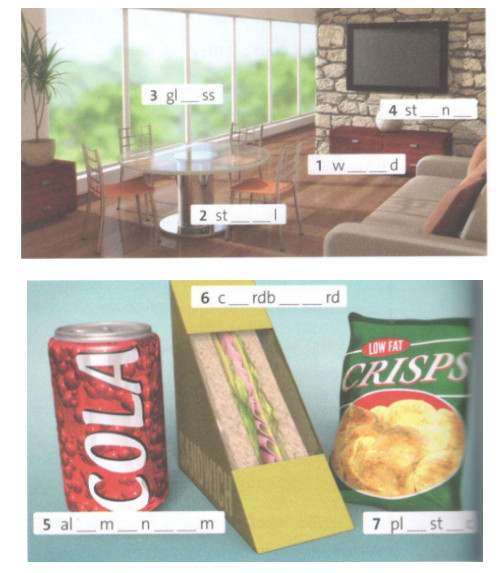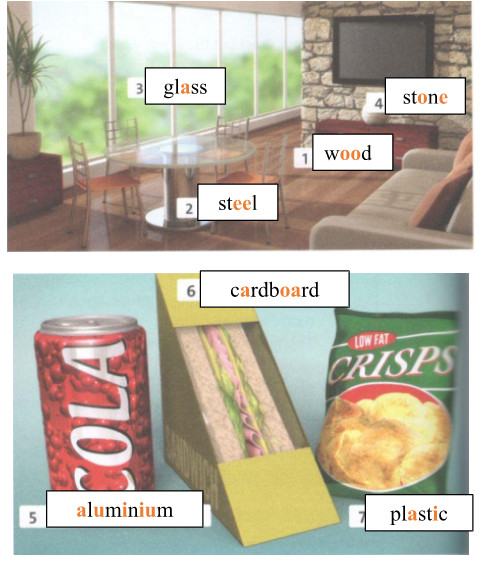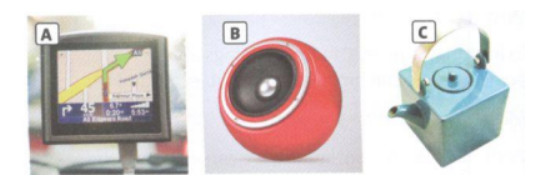8A - Unit 8. Science - SBT Tiếng Anh 10 Friends Global
1. Complete the list of materials using a, e, i, o and u. 2. Complete the sentences with the correct materials. 3. Answer the questions with the material words from exercises 1 and 2. Use each word only once. 4. Match the words below with the diagrams. 5. Listen to the sentences and match the objects to the descriptions. Write the correct letter: A, B or C.
Tổng hợp đề thi học kì 1 lớp 10 tất cả các môn - Chân trời sáng tạo
Toán - Văn - Anh - Lí - Hóa - Sinh - Sử - Địa...
Bài 1
1. Complete the list of materials using a, e, i, o and u.
(Hoàn thành danh sách các vật liệu bằng cách sử dụng a, e, i, o và u.)

Phương pháp giải:
Nghĩa của từ vựng
-
wood: gỗ
-
steel: thép
-
glass: kính
-
stone: sỏi
-
alumnium: bạc
-
cardboad: giấy carton
-
plastic: nhựa
Lời giải chi tiết:
| 1. wood | 2. steel | 3. glass | 4. stone | 5. aluminium | 6. cardboard | 7. plastic |

Bài 2
2. Complete the sentences with the correct materials.
(Hoàn thành các câu với các vật liệu chính xác.)
1 Shoes are often made of l______________________
2 Expensive rings are often made of g_________________
3 Car tyres are made of r_________________
4 Cups and plates are often c_________________ but sometimes they are made of c_________________
5 Books are made of p_________________
6 Pavements are often made of c_________________
7 Gates and fences are sometimes made of i_________________
8 Tents and backpacks are usually made of n_________________
9 In the past, coins were often made of c_________________
Phương pháp giải:
Nghĩa của từ vựng
-
leather: da
-
gold: vàng
-
rubber: cao su
-
ceramic: gốm sứ
-
paper: giấy
-
concrete: bê tông
-
iron: sắt
-
nylon: ni lông
-
copper: đồng
Lời giải chi tiết:
| 1. leather | 2. gold | 3. rubber | 4. ceramic - copper | 5. paper | 6. concrete | 7. iron | 8. nylon | 9. copper |
1 Shoes are often made of leather
(Giày thường được làm bằng da)
2 Expensive rings are often made of gold
(Những chiếc nhẫn đắt tiền thường được làm bằng vàng)
3 Car tyres are made of rubber
(Lốp ô tô được làm bằng cao su)
4 Cups and plates are often ceramic but sometimes they are made of copper
(Chén và đĩa thường bằng gốm nhưng đôi khi chúng được làm bằng đồng)
5 Books are made of paper
(Sách được làm bằng giấy)
6 Pavements are often made of concrete
(Vỉa hè thường được làm bằng bê tông)
7 Gates and fences are sometimes made of iron
(Cổng và hàng rào đôi khi được làm bằng sắt)
8 Tents and backpacks are usually made of nylon
(Lều và ba lô thường làm bằng nylon)
9 In the past, coins were often made of copper
(Trước đây, tiền xu thường được làm bằng đồng)
Bài 3
3. Answer the questions with the material words from exercises 1 and 2. Use each word only once.
(Trả lời các câu hỏi với các từ ngữ trong bài tập 1 và 2. Chỉ sử dụng mỗi từ một lần.)
1 Which of the materials come from trees?
paper _________________ _________________ _________________
2 Which of the materials are metals?
_________________ _________________ _________________ _________________ _________________
3 Which material is made from part of an animal?
_________________
4 Which very hard material do we find in the ground?
_________________
5 Which man-made materials do we make from oil?
_________________
6 Which materials do we make from other materials which we find in the ground?
_________________ _________________ _________________
Lời giải chi tiết:
1 Which of the materials come from trees?
paper wood rubber cardboard
(Vật liệu nào đến từ cây cối?
giấy, bìa cứng, cao su, gỗ)
2 Which of the materials are metals?
iron copper gold aluminium steel
(Vật liệu nào là kim loại?
sắt, đồng, vàng, nhôm, thép)
3 Which material is made from part of an animal?
leather
(Vật liệu nào được làm từ bộ phận của động vật?
da)
4 Which very hard material do we find in the ground?
stone
(Chúng ta tìm thấy vật liệu rất cứng nào trong lòng đất?
sỏi)
5 Which man-made materials do we make from oil?
nylon plastic
(Chúng ta tạo ra những vật liệu nhân tạo nào từ dầu mỏ?
nhựa, nylon)
6 Which materials do we make from other materials which we find in the ground?
glass ceramic concrete
(Những vật liệu nào chúng ta làm từ những vật liệu khác mà chúng ta tìm thấy trong lòng đất?
bê tông, gốm, thủy tinh)
Bài 4
4. Match the words below with the diagrams.
(Nối các từ dưới đây với sơ đồ.)
circular curved rectangular spherical
square straight triangular

1 _________________
2 _________________
3 __________________
4 __________________
5 __________________
6 __________________
7 __________________
Phương pháp giải:
Nghĩa của từ vựng
-
rectangular: hình chữ nhật
-
square: hình vuông
-
spherical: hình cầu
-
circular: dạng hình tròn
-
triangular: hình tam giác
-
curved: đường cong
-
straight: đường thẳng
Lời giải chi tiết:
1 rectangular
2 square
3 spherical
4 circular
5 triangular
6 curved
7 straight
Bài 5
5. Listen to the sentences and match the objects to the descriptions. Write the correct letter: A, B or C.
(Nghe các câu và nối đồ vật với phần mô tả. Viết đúng chữ cái: A, B hoặc C.)

1 ________________.
2 ________________.
3 ________________.
4 ________________.
5 ________________.
6 ________________.
7 ________________.
Phương pháp giải:
Bài nghe
1 It’s rectangular.
2 It’s spherical and it’s made of plastic and metal.
3 It prevents you from getting lost.
4 It’s got a metal lid and a metal handle.
5 It’s mostly made of plastic and it’s rechargeable.
6 It’s used for making tea.
7 It’s used for listening to music.
Bài dịch
1 Nó hình chữ nhật.
2 Nó có hình cầu và được làm bằng nhựa và kim loại.
3 Nó giúp bạn không bị lạc.
4 Nó có một nắp kim loại và một tay cầm bằng kim loại.
5 Nó chủ yếu được làm bằng nhựa và có thể sạc lại được.
6 Nó được sử dụng để pha trà.
7 Nó được sử dụng để nghe nhạc.
Lời giải chi tiết:
| 1. A | 2. B | 3. A | 4. C | 5. A | 6. B | 7. C | 8. B |
- 8B - Unit 8. Science - SBT Tiếng Anh 10 Friends Global
- 8C - Unit 8. Science - SBT Tiếng Anh 10 Friends Global
- 8D - Unit 8. Science - SBT Tiếng Anh 10 Friends Global
- 8E - Unit 8. Science - SBT Tiếng Anh 10 Friends Global
- 8F - Unit 8. Science - SBT Tiếng Anh 10 Friends Global
>> Xem thêm
Luyện Bài Tập Trắc nghiệm Tiếng Anh 10 - Friends Global - Xem ngay












